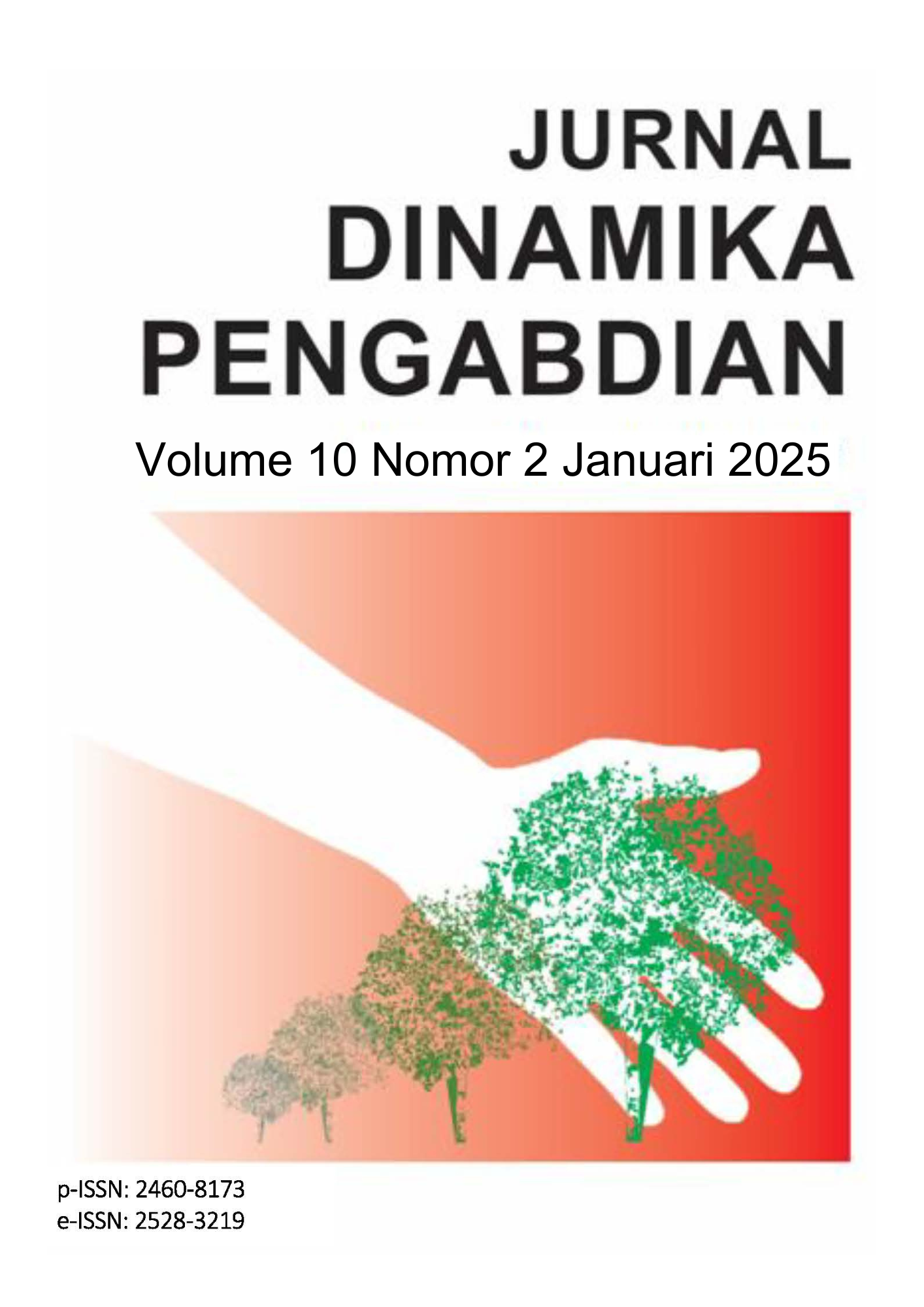IMPLEMENTASI TEKNOLOGI SLOW-RELEASE FERTILIZER PADA USAHATANI TEMBAKAU KELOMPOK TANI MAMMINASA DECENG DI KABUPATEN SOPPENG
DOI:
https://doi.org/10.20956/jdp.v10i2.39673Keywords:
Bina desa, Retensi nitrogen, Efisiensi serapan hara, produktivitasAbstract
Peningkatan retensi nitrogen pada lahan tembakau merupakan strategi penting peningkatan mutu dan produksi tembakau. Pupuk slow release dari biochar sumber nitrogen dari pupuk kimia, urin sapi dan bakteri diyakini mampu meningkatkan retensi nitrogen dan efisien serapan hara. Oleh karena itu kegiatan ini bertujuan untuk mengimplementasikan penggunaan pupuk slow release pada budidaya tembakau. Metode pelaksanaan kegiatan meliputi: 1) penyuluhan penggunaan bahan pembenah tanah; 2) pendampingan produksi pupuk slow release; 3) pendampingan pembibitan tembakau standar SNI; 4) demplot penerapan GAP pada budidaya tembakau; dan 5) pemantauan aplikasi pupuk slow release dan pertumbuhan tanaman. Hasil kegiatan menunjukkan partisipasi aktif petani dari 2 kelompok tani yakni Mamminasa Deceng dan Alemarajae serta perwakilan dari GAPOKTAN Ujung Rilau, dimana berhasil diproduksi pupuk slow release sebanyak tiga formula, yakni 1) Biochar + SP36; 2) Biochar + SP36 + urin sapi; dan 3) Biochar + SP36 + urin sapi + Azotobacter. Keempat formulasi pupuk telah distandarisasi oleh lembaga sertifikasi karbon internasional Biochar Life, sehingga dapat direkomendasikan untuk diterapkan di lahan pertanian khususnya lahan tembakau.
Kata kunci: Bina desa, retensi nitrogen, efisiensi serapan hara, produktivitas.
ABSTRACT
Increasing nitrogen retention in tobacco fields is an important strategy to improve tobacco quality and production. Slow-release fertilizer from biochar, a source of nitrogen from chemical fertilizers, cow urine and bacteria, is believed to be able to increase nitrogen retention and efficient nutrient absorption. Therefore, this activity aims to implement the use of slow-release fertilizer in tobacco cultivation. The implementation methods of the activity include: 1) counseling on the use of soil conditioners; 2) assistance in the production of slow-release fertilizers; 3) assistance in the production of SNI standard tobacco; 4) demonstration plots for the application of GAP in tobacco cultivation and; 5) monitoring the application of slow-release fertilizers and plant growth. The results of the activity showed the active participation of farmers from 2 farmer groups, namely Mamminsa Deceng and Alemarajae, and representatives from GAPOKTAN Ujung Rilau, where three formulas of slow-release fertilizers were successfully produced, namely 1) Biochar + SP36; 2) Biochar + SP36 + Cow urine; and 3) Biochar + SP36 + Cow urine + Azotobacter. The four fertilizer formulations have been standardized by the international carbon certification body Biochar Life so that they can be recommended for application on agricultural land, especially tobacco land.
Keywords: Village development, nitrogen retention, nutrient uptake efficiency, productivity.
References
Ahmad, M., Rajapaksha, A. U., Lim, J. E., Zhang, M., Bolan, N., Mohan, D., Vithanage, M., Lee, S. S., & Ok, Y. S. (2014). Biochar as a sorbent for contaminant management in soil and water: A review. In Chemosphere. https://doi.org/10.1016/j.chemosphere.2013.10.071
Barreca, S., Orecchio, S., & Pace, A. (2014). The effect of montmorillonite clay in alginate gel beads for polychlorinated biphenyl adsorption: Isothermal and kinetic studies. Applied Clay Science, 99, 220–228. https://doi.org/10.1016/j.clay.2014.06.037
BPS, S. (2024). Katalog/Catalog : 1102001.7312.
Cen, Z., & Wei, L. (2021). Assessment of a Biochar-Based Controlled Release Nitrogen Fertilizer Coated with Polylactic Acid Assessment of a Biochar-Based Controlled Release Nitrogen Fertilizer Coated with Polylactic Acid. May. https://doi.org/10.1007/s42729-021-00497-x
Contreras-abara, P., Castillo, T., Urtuvia, V., & Peña, C. (2023). Continuous Bioproduction of Alginate Bacterial under Nitrogen Fixation and Nonfixation Conditions. 1–14.
Costa, O. Y. A., Raaijmakers, J. M., & Kuramae, E. E. (2018). Microbial extracellular polymeric substances: Ecological function and impact on soil aggregation. Frontiers in Microbiology, 9(JUL), 1–14. https://doi.org/10.3389/fmicb.2018.01636
Davis, T. A., Volesky, B., & Mucci, A. (2003). A review of the biochemistry of heavy metal biosorption by brown algae. 37, 4311–4330. https://doi.org/10.1016/S0043-1354(03)00293-8
Etesami, H., & Maheshwari, D. K. (2018). Use of plant growth promoting rhizobacteria (PGPRs) with multiple plant growth promoting traits in stress agriculture: Action mechanisms and future prospects. Ecotoxicology and Environmental Safety, 156(October 2017), 225–246. https://doi.org/10.1016/j.ecoenv.2018.03.013
Goh, C. H., Heng, P. W. S., & Chan, L. W. (2012). Alginates as a useful natural polymer for microencapsulation and therapeutic applications. Carbohydrate Polymers, 88(1), 1–12. https://doi.org/10.1016/j.carbpol.2011.11.012
Korsmeyer-peppas, T. (2023). Preparation and characterization of biochar-based slow-release nitrogen fertilizer and its effect on maize growth. 1, 28–30.
Kurt, D., & Kinay, A. (2021). Industrial Crops & Products Effects of irrigation , nitrogen forms and topping on sun cured tobacco. Industrial Crops & Products, 162(November 2020), 113276. https://doi.org/10.1016/j.indcrop.2021.113276
Lisuma, J. B., Mbega, E. R., & Ndakidemi, P. A. (2021). The Effects of Cultivating Tobacco and Supplying Nitrogenous Sandy Soils.
Nasser, A. Mingelgrin, U. and Gerstl, Z. (2008). Effect of Soil Moisture on the Release of Alachlor from Alginate-Based Controlled-Release Formulations. 1322–1327. https://doi.org/doi: 10.1021/jf0718392.
Nosrati, R., Owlia, P., Saderi, H., Olamaee, M., Rasooli, I., & A, A. T. (2012a). Correlation between nitrogen fixation rate and alginate productivity of an indigenous Azotobacter vinelandii from Iran. 4(3), 153–159.
Nosrati, R., Owlia, P., Saderi, H., Olamaee, M., Rasooli, I., & A, A. T. (2012b). Correlation between nitrogen fixation rate and alginate productivity of an indigenous Azotobacter vinelandii from Iran. 4(3), 153–159. https://www.ncbi.nlm.nih.gov/pmc/articles/PMC3465543/
Noviyanti, E. D. (n.d.). Penggunaan kompleks polielektrolit alginat-gelatin sebagai matriks dalam sediaan tablet lepas lambat = The use of alginate-gelatin polielectrolyte complex as matrix for sustained release tablet. 5, 478.
Oleszczuk, P. (2022). Biochar and engineered biochar as slow- and controlled-release fertilizers. 339(March).
Pang, W., Hou, D., Wang, H., Sai, S., Wang, B., Ke, J., Wu, G., Li, Q., & Holtzapplec, M. T. (2018). Preparation of Microcapsules of Slow-Release NPK Compound Fertilizer and the Release Characteristics. 29(11), 2397–2404.
Rasse, D. P., Weldon, S., Joner, E. J., Joseph, S., Kammann, C. I., Liu, X., Toole, A. O., Pan, G., & Schumacher, N. P. K. (2022). Enhancing plant N uptake with biochar-based fertilizers : limitation of sorption and prospects. Plant and Soil, 213–236. https://doi.org/10.1007/s11104-022-05365-w
Sepúlveda, C., Jhon, C., Maicol, H. R., Evelyn, T., & Agudelo, B. (2021). Evaluation of a Biochar ‑ Based Slow ‑ Release P Fertilizer to Improve Spinacia oleracea P Use , Yield , and Nutritional Quality. Journal of Soil Science and Plant Nutrition, 0123456789. https://doi.org/10.1007/s42729-021-00583-0
Sukmawati, Ala, A., Baharuddin, & Gusli, S. (2020). Biochar interventions enriched with alginate-producing bacteria support the growth of maize in degraded soils Biochar interventions enriched with alginate-producing bacteria support the growth of maize in degraded soils. IOP Conf. Series: Earth and Environmental Science 484 (2020) 012133. https://doi.org/10.1088/1755-1315/486/1/012133
Sukmawati, Ala, A., Patandjengi, B., & Gusli, S. (2020). Exploring of promising bacteria from the rhizosphere of maize, cocoa and lamtoro. Biodiversitas, 21(12), 5665–5673. https://doi.org/10.13057/biodiv/d211224
Wang, C., Luo, D., Zhang, X., Huang, R., Cao, Y., Liu, G., Zhang, Y., & Wang, H. (2022). Biochar-based slow-release of fertilizers for sustainable agriculture: A mini review. Environmental Science and Ecotechnology, 10, 100167. https://doi.org/10.1016/j.ese.2022.100167
Wang, C., Sun, R., & Huang, R. (2021). Highly dispersed iron-doped biochar derived from sawdust for Fenton-like degradation of toxic dyes. Journal of Cleaner Production, 297, 126681. https://doi.org/10.1016/j.jclepro.2021.126681
Zhou, J., Qu, T., Li, Y., Zwieten, L. Van, Wang, H., Chen, J., Song, X., Lin, Z., Zhang, X., Luo, Y., & Cai, Y. (2021). Biochar-based fertilizer decreased while chemical fertilizer increased soil N 2 O emissions in a subtropical Moso bamboo plantation. Catena, 202(February), 105257. https://doi.org/10.1016/j.catena.2021.105257
Downloads
Published
How to Cite
Issue
Section
License
Copyright (c) 2025 Jurnal Dinamika Pengabdian

This work is licensed under a Creative Commons Attribution 4.0 International License.
Penulis diwajibkan untuk menandatangani "Surat Perjanjian Hak Cipta" atau Copyright Agreement untuk penyerahan ijin kepada pihak jurnal untuk menerbitkan tulisannya.
Authors are required to sign a "Copyright Agreement" to submit permission to the journal to publish their writings.







